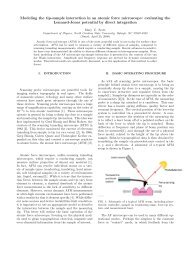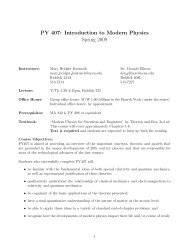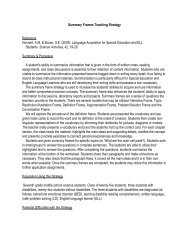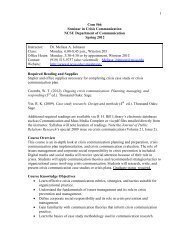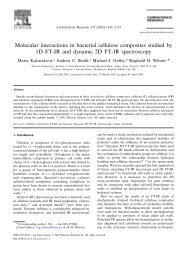Sampling Reese's Pieces Activity
Sampling Reese's Pieces Activity
Sampling Reese's Pieces Activity
Create successful ePaper yourself
Turn your PDF publications into a flip-book with our unique Google optimized e-Paper software.
<strong>Sampling</strong> Reese’s <strong>Pieces</strong> – Student Handout<br />
This activity is based on an adaptation by Joan Garfield and Dani Ben-Zvi of an activity from Rossman and<br />
Chance (2000), Workshop Statistics: Discovery with Data, 2nd Edition.<br />
1. Reese’s <strong>Pieces</strong> candies have three colors: orange, brown, and yellow. Which color<br />
do you think has more candies in a package: orange, brown or yellow?<br />
2. Guess the proportion of each color in a bag:<br />
Orange____<br />
Brown____ Yellow______<br />
3. If each student in the class takes a sample of 25 Reese’s pieces, would you expect<br />
every student to have the same number of orange candies in their sample?<br />
Explain.<br />
4. Pretend that 10 students each took samples of 25 Reese’s pieces. Write down the<br />
number of orange candies you might expect for these 10 samples:<br />
___ ___ ___ ___ ___ ___ ___ ___ ___ ___<br />
These numbers represent the variability you would expect to see in the number of<br />
orange candies in 10 samples of 25 pieces.<br />
You will be given a cup that is a random sample of Reese’s pieces. Count out 25<br />
candies from this cup without paying attention to color. In fact, try to IGNORE the<br />
colors as you do this.<br />
5. Now, count the colors for your sample and fill in the chart below:<br />
Orange Yellow Brown<br />
Number of candies _____ _____ _____<br />
Proportion of candies _____ _____ _____<br />
(divide each NUMBER<br />
by 25)<br />
Write the number AND the proportion of orange candies in your sample on the board.<br />
Mark where each value should be on the two dotplots your teacher constructs (one for<br />
number of oranges, one for proportion of oranges).<br />
1
I. Discussion: The proportions are the sample statistics. For example, the proportion of<br />
orange candies in your sample is the statistic that summarizes your sample.<br />
How does this relate to the population parameter (the proportion of all orange<br />
Reese’s <strong>Pieces</strong> produced by Hershey Co.)?<br />
Do you know the value of the parameter?<br />
Do you know the values of the statistics?<br />
Does the value of the parameter change, each time you take a sample?<br />
Does the value of the statistic change each time you take a sample?<br />
Did everyone in the class have the same number of orange candies?<br />
How do the actual sample values compare to the ones you estimated earlier?<br />
Did everyone have the same proportion of orange?<br />
Describe the variability of the distribution of sample proportions on the board<br />
in terms of shape, center, and spread.<br />
II. Focus on the proportion of orange candies.<br />
Simulate data and tie this activity to the Three-Tier Simulation Process Model (SPM).<br />
Use the SPM to fill in information for the three tiers:<br />
Population:<br />
Samples and sample statistics:<br />
Distribution of sample statistics:<br />
Fill in the details of the distribution that was put of the board in the SPM below:<br />
2
Based on the distribution we obtained (on the board), what would you ESTIMATE to<br />
be the population parameter, the proportion of orange Reese’s pieces produced by<br />
Hershey?<br />
What if everyone in the class only took 10 candies, in their sample instead of 25? Do<br />
you think the graphs on the board would look the same? If not, how would they be<br />
different?<br />
What if everyone in the class took 100 candies? Would the distributions on the board<br />
change at all? If so, how?<br />
III. The Reese’s <strong>Pieces</strong> Applet<br />
Instead of trying this activity again with fewer or more candies, simulate the activity<br />
using a web applet. Go to www.rossmanchance.com/applets/, and look at the bottom<br />
of the far right column to find Java Applets. Click on Java Applets and look for<br />
<strong>Sampling</strong> Distributions, and click on Reese’s <strong>Pieces</strong>. You will see a big container of<br />
colored candies: that represents the POPULATION.<br />
How many orange candies are in the population?<br />
You will see that the proportion of orange is already set at .45, so that is the<br />
population parameter. (People who have counted lots of Reese’s pieces came up<br />
with this number).<br />
How does .45 compare to the proportion of orange candies in your sample?<br />
How does it compare to the center of the class’ distribution?<br />
Click on the “draw samples” button. One sample of 25 candies will be taken and the<br />
proportion of means for this sample is plotted on the graph. Repeat this again.<br />
Do you get the same or different values for each sample?<br />
How do these numbers compare to the ones our class obtained?<br />
How close is each sample statistic (proportion) to the POPULATION<br />
PARAMETER?<br />
Turn off the animation and change the number of samples to 100.<br />
Click on draw samples, and see the distribution of sample statistics built.<br />
Describe its shape, center and spread.<br />
How does this compare to the one our class constructed on the board?<br />
4
IV. Test your conjectures<br />
What happens to this distribution of sample statistics as we change the number of<br />
candies in each sample (sample size).<br />
First, change the sample size to 10 and draw 100 samples<br />
.<br />
How close is each sample statistic (proportion) to the POPULATION<br />
PARAMETER?<br />
Next, change the sample size to 100 and draw 100 samples.<br />
V. Sample Size<br />
How close is each sample statistic (proportion) to the POPULATION<br />
PARAMETER?<br />
As the sample size increases, what happens to how well the sample statistics resemble<br />
the population parameter?<br />
Now, describe the effect of sample size on the distributions of sample statistics.<br />
Note: When we generate sample statistics and graph them we are generating an<br />
estimated SAMPLING DISTRIBUTION, or a distribution of the sample<br />
statistics. It looks like other distributions we have seen of raw data. What’s<br />
different about this?<br />
We now need to distinguish between THREE kinds of distributions of data:<br />
Distribution of population<br />
Distribution of one sample of data<br />
Distribution of sample statistics for many samples.<br />
Show where each of the distributions are represented on the SIMULATION PROCESS<br />
MODEL. Be sure to turn this in before you leave class today.<br />
5



